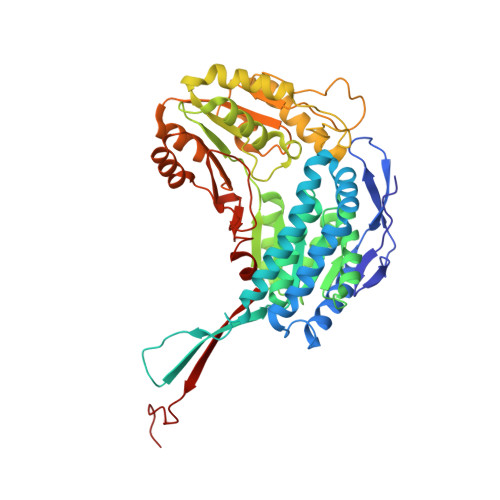Amino Acid Residues Critical for the Specificity for Betaine Aldehyde of the Plant Aldh10 Isoenzyme Involved in the Synthesis of Glycine Betaine.
Diaz-Sanchez, A.G., Gonzalez-Segura, L., Mujica-Jimenez, C., Rudino-Pinera, E., Montiel, C., Martinez-Castilla, L.P., Munoz-Clares, R.A.(2012) Plant Physiol 158: 1570
- PubMed: 22345508
- DOI: https://doi.org/10.1104/pp.112.194514
- Primary Citation of Related Structures:
4A0M - PubMed Abstract:
Plant Aldehyde Dehydrogenase10 (ALDH10) enzymes catalyze the oxidation of ω-primary or ω-quaternary aminoaldehydes, but, intriguingly, only some of them, such as the spinach (Spinacia oleracea) betaine aldehyde dehydrogenase (SoBADH), efficiently oxidize betaine aldehyde (BAL) forming the osmoprotectant glycine betaine (GB), which confers tolerance to osmotic stress. The crystal structure of SoBADH reported here shows tyrosine (Tyr)-160, tryptophan (Trp)-167, Trp-285, and Trp-456 in an arrangement suitable for cation-π interactions with the trimethylammonium group of BAL. Mutation of these residues to alanine (Ala) resulted in significant K(m)(BAL) increases and V(max)/K(m)(BAL) decreases, particularly in the Y160A mutant. Tyr-160 and Trp-456, strictly conserved in plant ALDH10s, form a pocket where the bulky trimethylammonium group binds. This space is reduced in ALDH10s with low BADH activity, because an isoleucine (Ile) pushes the Trp against the Tyr. Those with high BADH activity instead have Ala (Ala-441 in SoBADH) or cysteine, which allow enough room for binding of BAL. Accordingly, the mutation A441I decreased the V(max)/K(m)(BAL) of SoBADH approximately 200 times, while the mutation A441C had no effect. The kinetics with other ω-aminoaldehydes were not affected in the A441I or A441C mutant, demonstrating that the existence of an Ile in the second sphere of interaction of the aldehyde is critical for discriminating against BAL in some plant ALDH10s. A survey of the known sequences indicates that plants have two ALDH10 isoenzymes: those known to be GB accumulators have a high-BAL-affinity isoenzyme with Ala or cysteine in this critical position, while non GB accumulators have low-BAL-affinity isoenzymes containing Ile. Therefore, BADH activity appears to restrict GB synthesis in non-GB-accumulator plants.
Organizational Affiliation:
Departamento de Bioquímica, Facultad de Química, Universidad Nacional Autónoma de México, Ciudad Universitaria, 04510 Mexico Distrito Federal, Mexico.

















